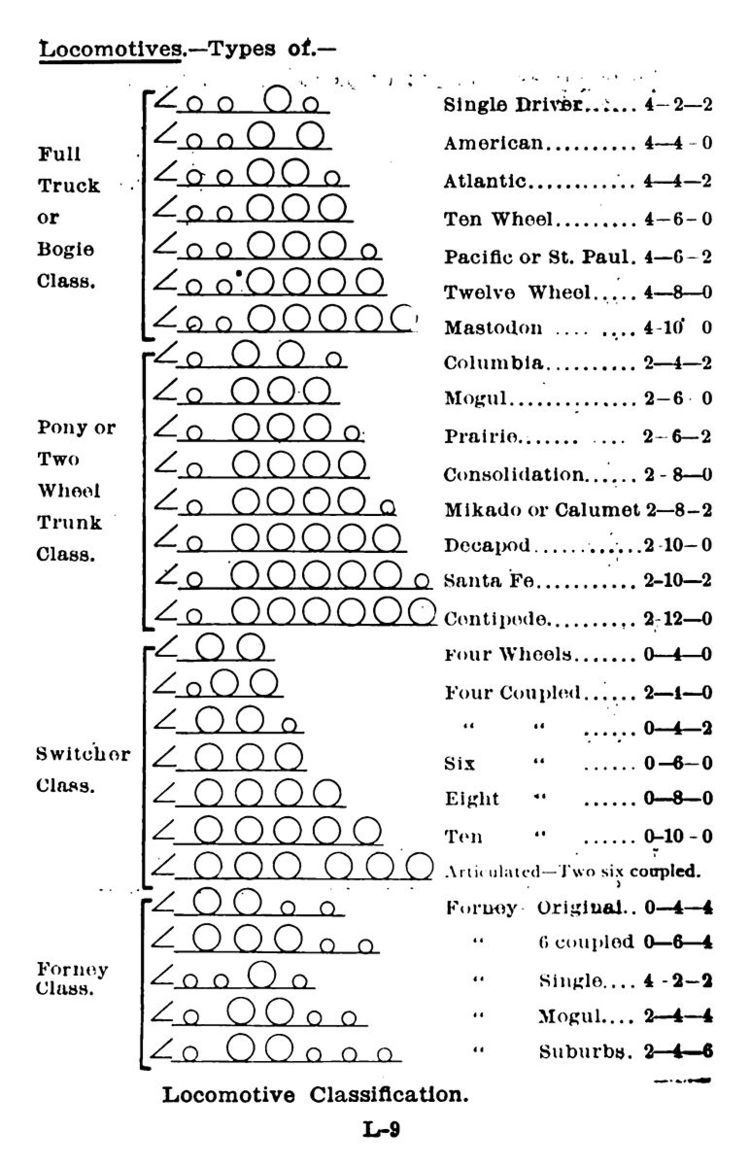 | ||
The Whyte notation for classifying steam locomotives by wheel arrangement was devised by Frederick Methvan Whyte, and came into use in the early twentieth century following a December 1900 editorial in American Engineer and Railroad Journal. The notation counts the number of leading wheels, then the number of driving wheels, and finally the number of trailing wheels, groups of numbers being separated by dashes. Other classification schemes, like UIC classification and the French, Turkish and Swiss systems for steam locomotives, count axles rather than wheels.
Contents
- Articulated locomotives
- Duplex locomotives
- Suffixes
- Internal combustion locomotives
- Limitations
- Naming
- Common wheel arrangements
- References
In the notation a locomotive with two leading axles (four wheels) in front, then three driving axles (six wheels) and then one trailing axle (two wheels) is classified as 4-6-2.
Articulated locomotives
Articulated locomotives such as Garratts, which are effectively two locomotives joined by a common boiler, have a + between the arrangements of each engine. Thus a "double Pacific" type Garratt is a 4-6-2+2-6-4. For Garratt locomotives the + sign is used even when there are no intermediate unpowered wheels, e.g. the LMS Garratt 2-6-0+0-6-2. This is because the two engine units are more than just power bogies. They are complete engines, carrying fuel and water tanks. The + sign represents the bridge (carrying the boiler) that links the two engines.
Simpler articulated types such as Mallets, have a jointed frame under a common boiler where there are no unpowered wheels between the sets of powered wheels. Typically, the forward frame is free to swing, whereas the rear frame is rigid with the boiler. Thus a Union Pacific Big Boy is a 4-8-8-4; four leading wheels, one group of eight driving wheels, another group of eight driving wheels, and then four trailing wheels.
Duplex locomotives
This numbering system is shared by duplex locomotives, which have powered wheel sets sharing a rigid frame.
Suffixes
No suffix means a tender locomotive.
T indicates a tank locomotive: in European practice, this is sometimes extended to indicate the type of tank locomotive: T means side tank, PT pannier tank, ST saddle tank, WT well tank. T+T means a tank locomotive that also has a tender.
In Europe, the suffix R can signify rack (0-6-0RT) or reversible (0-6-0TR), the latter being Bi-cabine locomotives used in France.
The suffix F indicates a fireless locomotive (0-4-0F). This locomotive has no tender.
Other suffixes have been used, including ng for narrow-gauge (less than 1,435 mm (4 ft 8 1⁄2 in) ) and CA or ca for compressed air (running on compressed air from a tank instead of steam from a boiler).
Internal combustion locomotives
In Britain, small diesel and petrol locomotives are usually classified in the same way as steam locomotives, e.g. 0-4-0, 0-6-0, 0-8-0. This may be followed by D for diesel or P for petrol, and another letter describing the transmission: E for electric, H hydraulic, M mechanical. Thus 0-6-0DE denotes a six-wheel diesel locomotive with electric transmission. Where the axles are coupled by chains or shafts (rather than side rods) or are individually driven, the terms 4w, 6w or 8w are generally used. Thus 4wPE indicates a four-wheel petrol locomotive with electric transmission. For large diesel locomotives the UIC classification is used.
Limitations
The main limitation of Whyte Notation is that it does not cover non-standard types such as Shay locomotives, which use geared trucks rather than driving wheels. The most commonly used system in Europe outside the United Kingdom is UIC classification, based on German practice, which can define the exact layout of a locomotive.
Naming
In American (and to a lesser extent British) practice, most wheel arrangements in common use were given names, sometimes from the name of the first such locomotive built. For example, the 2-2-0 type arrangement is named Planet, after the 1830 locomotive on which it was first used. (This naming convention is similar to the naming of warship classes.)
Common wheel arrangements
The most common wheel arrangements are listed below. In the diagrams, the front of the locomotive is to the left.
